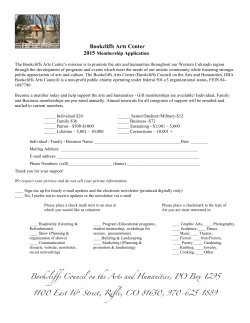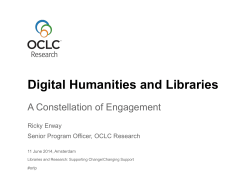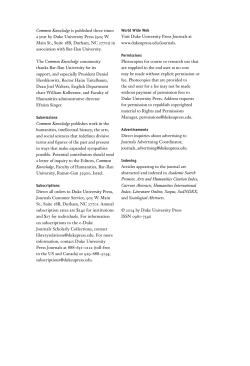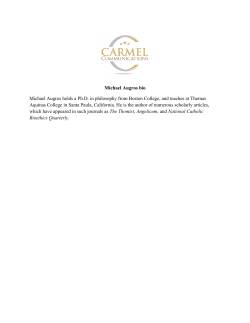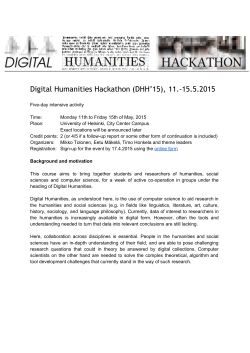
the humanities - CIBER
Trust in scholarly communications in text the digital age: the humanities text CAR PURCHASE COMPARI Professor David Nicholas, CIBER Research All change? CAR PURCHASE COMPARI • Always perceived as different (soft), but are differences weakening as result of everyone using same digital platforms (web, smartphone and social media) and being evaluated in same ways? • So are disciplinary differences a thing of the past? Will they change or will they stamp their own unique footprint on scholarly communications? • Oldest kid arrives on the digital block with e-books and digital objects now in hand. Last to make the transition to the digital but what are they making of it? • Going to examine humanities scholars behaviour through prism of some recent research CIBER have conducted about using/reading, citing and disseminating scholarly content in digital age Using and reading behaviour CAR PURCHASE COMPARI • Scholarly activity which is least prescribed for researchers • It is here where they are more likely to innovate, experiment and just do what they like – embrace the new • If going to see anything change it is here that we shall see it • Identified 15 activities associated with determining what to use, just showing what a complex activity it is • Humanities the odd one out in regard to 12 of these activities Usage: activities undertaken in order to determine what to use/read CAR PURCHASE COMPARI In general the most highly rated activities: •Checking that arguments and logic are sound •Checking to see if research data credible •Reading the full-text Compared to other disciplines Humanities more likely to: •Read the full-text •Check means by which the source had been disseminated (e.g. journal, blog) •Check the name of author, journal and publisher •Take account of discovery platform (e.g. library catalogue) Compared to than other disciplines less likely to: •Go by the abstract •Take into account usage data Usage: trustworthiness of sources CAR PURCHASE COMPARI Given a range of statements (8) regarding the trustworthiness of sources Humanists, as other scholars, agree most with these statements: •I am very likely to read an article recommended to me by a colleague •Peer-reviewed journals are the most trustworthy information sources Humanities scholars trust open access publishing and Wikipedia as much as the other disciplines However, more lukewarm regarding trust proxies, such as impact factors and while peer review journals are trusted highly, not quite as highly as in other disciplines Citing CAR PURCHASE COMPARI • In terms of importance citing comes between usage and publishing. A prescribed and important activity for scholars, which comes with rules • However, researchers read many articles and only cite a few of them, so selection is required and trustworthiness a key part of the process. Citing CAR PURCHASE COMPARI . Some interesting divergences between disciplines • Humanities researchers more likely to: • cite the seminal source in the field, whereas life scientists prefer to cite the most recent source • cite non-peer reviewed sources (e.g., personal correspondence, newspaper articles, blogs, tweets) • Humanities researchers less likely to use citations for ‘gaming’ purposes, such as citing: a) one’s own publications; b) reviewer suggestions; c) journal to which submitted Publishing and disseminating research CAR PURCHASE COMPARI • Activity where academic careers and reputations are made and clearly trustworthiness is a big factor • Researchers clearly want to publish in sources that are held to be high status and hence trustworthy. • Thus publishing focuses the academic mind on trustworthiness issues and we can learn a lot about the process. Publishing and disseminating research: attributes looked for CAR PURCHASE COMPARI Asked to comment on attributes of 10 publishing outlets Humanities scholars odd one out in 6 cases Humanities scholars, like others, rated most highly outlets that are: •Highly relevant to my field •Peer reviewed •Published by traditional scholarly publisher Differed from scholars in other disciplines rating more highly: •Traditional scholarly publishers •Reputation of editorial board And rating more lowly: •Being highly cited Fact that an outlet is open access in not seen to be very important Traditional practices hold sway, but question mark over digital outlets thing of the past Publishing and disseminating research: influence of institutional policies CAR PURCHASE COMPARI Researchers most frequently pressed to publish: • in international journals • high impact factor journals • traditional sources, such as journals and monographs Few researchers, irrespective of discipline, pressed to use the social media for publishing or dissemination purposes, but moderate pressure to publish in open access journals Humanities researchers more likely to agree: • that they are influenced to publish in traditional sources and hardcopy ones than their colleagues from other disciplines Conclusions CAR PURCHASE COMPARI Lots in common But Humanities researches differ in that: • Journals and metrics that service them not so important. While scientists largely unquestioning about merits of metrics; social scientists slightly uneasy, but feel there is little choice; whereas humanities scholars feel culturally uncomfortable and alienated • Humanities scholars, like early career researchers, more likely to use social media, especially so to disseminate research to target audiences • Biggest and most welcome change for humanities scholars over the past decade is that closer ties with researchers, enabled by digital communication, makes it easier to judge trustworthiness of content. They prefer the personal touch Back to question posed at beginning: are humanities researchers losing their uniqueness because of common use of a platforms and search/discovery tools (Google and Google Scholar) and growing institutional pressures? Seems answer is in some respects yes, but not in all respects The evidence base CAR PURCHASE COMPARI • Trust and authority in scholarly communications in the light of the digital transition research project, 2013. 3650 plus survey respondents (all countries) plus several hundred (UK/USA) interviewees. Looked at using/reading, citing and disseminating behavior. • With supplementary data from Emerging reputation mechanisms for scholars research project, 2014-2015. 250 plus EU survey respondents and nearly a 100 interviews. Looked at the impact of social media, online communities and the likes of ResearchGate and Academia.edu on scholarly reputation • See more at http://ciber-research.eu/
© Copyright 2025
